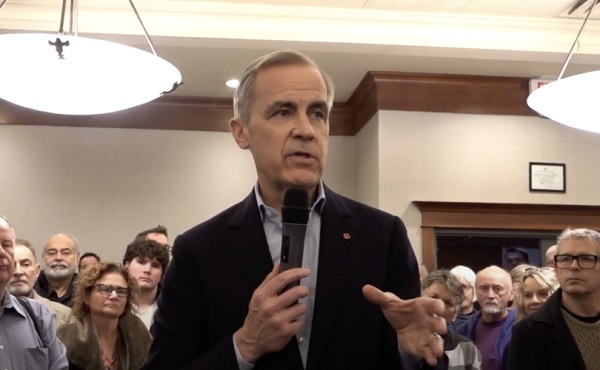MAiD
Canada’s euthanasia regime considers death less harmful than offering help to live

From LifeSiteNews
A Canadian judge has ordered an injunction from a father to be lifted so that his 27-year-old autistic daughter can be permitted to undergo a doctor-assisted suicide.
On March 14, I reported on the story of a 27-year-old Albertan woman with autism who had been approved for euthanasia in December; she was planning to receive a lethal injection on February 1 when her father, whom she lives with, successfully obtained a temporary court injunction the day prior. Her father argued that her autism and “possibly other undiagnosed maladies do not satisfy the eligibility criteria for MAiD [Medical Assistance in Dying]”; the daughter’s attorney argued that it was “none of [her father’s] business.”
It fell to Court of King’s Bench Justice Colin Feasby to examine the approval process and to determine whether the young woman was eligible for suicide-by-doctor. He admitted to being troubled by the case. “As a court, I can’t go second guessing these MAiD assessors… but I’m stuck with this: the only comprehensive assessment of this person done says she’s normal,” Feasby stated. “That’s really hard.” It shouldn’t have been.
The desperate father has received another brutal setback in his quest to save his daughter from Canada’s euthanasia regime. On March 25, Feasby ruled that the injunction preventing her death be lifted. As the Calgary Herald put it: “Preventing a Calgary woman’s medically assisted death would cause her irreparable harm, a judge ruled Monday.” Reread that sentence a moment and let it sink in: preventing a woman’s death would cause her irreparable harm. In Canada’s euthanasia regime, words mean nothing. Suicide is healthcare. Stopping suicide causes irreparable harm. Death… doesn’t, somehow.
“The harm to MV [the woman in question] if the injunction is granted goes to the core of her being,” Feasby stated in his written ruling. “An injunction would deny MV the right to choose between living or dying with dignity. Further, an injunction would put MV in a position where she would be forced to choose between living a life she has decided is intolerable and ending her life without medical assistance. This is a terrible choice that should not be forced on MV, as attempting to end her life without medical assistance would put her at increased risk of pain, suffering, and lasting injury.”
Note here that there is no limiting principle to this ruling. That logic, such as it is, would apply to any suffering person experiencing suicidal ideation. It is also a false choice. The choice is not between dying by lethal injection or dying by some other form of suicide; it is between dying by lethal injection or being cared for by her loving father, who is ready and willing to do whatever he can for her. As Feasby himself said in his previous comments on the case: “The only comprehensive assessment of this person done says she’s normal.” Apparently, that didn’t matter.
Addressing the young woman in his ruling, Feasby added:
What I know of your journey through the health-care system from the evidence in this case suggests that you have struggled to find a doctor who could diagnose your condition and offer appropriate treatment. I do not know why you seek MAiD. Your reasons remain your own because I have respected your autonomy and your privacy. My decision recognizes your right to choose medically assisted death; but it does not require you to choose death.
Keen readers will notice that these statements are also in conflict. The young woman “struggled to find a doctor who could diagnose your condition and offer appropriate treatment”; that is why she is seeking euthanasia. Feasby can pretend not to know this, but the evidence is clear.
Feasby did admit that his ruling would be deeply harmful to the parents of the young woman. “The harm to WV [the father] if the injunction is not granted will be substantial,” he wrote. “The pain of losing a child, even an adult child, is not something that any parent should experience. (The parents) have devoted their lives to raising MV from birth and have continued to support her since she has come of age. They will understandably be devastated by her death. For many parents, the loss of a child is a life-changing event that they never truly recover from. The loss is immeasurable.”
He is right. He could have made a different decision. The 27-year-old had to shop around for doctors willing to sign off on her application for euthanasia; she initially struggled to find the necessary two. But in the end, she succeeded. The father can appeal Feasby’s decision, but his attorney has not commented on whether he will do so. If he does not, he will face what so many Canadian families have endured over the past several years: the knowledge that his family member will expedite her death, and that he is helpless to stop it.
2025 Federal Election
Mark Carney is trying to market globalism as a ‘Canadian value.’ Will it work?

From LifeSiteNews
By Frank Wright
A campaign to appeal to national sentiment is a strange gambit for Liberals – committed as they are to the replacement of the nation with globalist policies.
The storm over Donald Trump’s threatened tariffs over the Canadian border crisis has been baked into a vote-winning meme by Canada’s Liberal Party. Yet with an election only weeks away on April 28, can a sentimental appeal to a vanished Canada secure a win for Mark Carney?
Trump’s tariffs were expected to hit Canada on Wednesday’s “Liberation Day,” refueling a furor over Canadian sovereignty which has led some to say this is “shaping up to be the trade war election.”
Responding to the tariffs, which ultimately never came to fruition in the way the Liberals were warning, a meme war broke out with Carney responding to harsh reality with a feelgood slogan.
Elbows up, Canada. pic.twitter.com/0gJ2opnPjZ
— Mark Carney (@MarkJCarney) March 22, 2025
“Elbows up!” is the new Current Thing in Canada, a media craze designed to stir nationalist indignation in elderly voters who may even remember the 1950s origin of the phrase.
The elbows refer to those of Gordie Howe – a 1950s hockey legend from Saskatchewan – a conservative province – and from a time when Canada was populated by Canadians.
It bears all the hallmarks of an “astroturf” campaign – intended to look authentic, but in reality a manufactured mass belief for marketing purposes.
“Elbows up” seeks to inspire a fighting mood against the threat – or promise – of tariffs on Canadian trade with the U.S.
Carney will ‘cave’
It is a classic example of the manipulation of popular feeling into political allegiance. How will the feelings of aging voters affect the imposition of tariffs? Not at all. Nor will the Canadian Prime Minister be able to stop them.
Insider reports say that Carney will “quietly cave” to Donald Trump over the issue, if the U.S. president does indeed go forward with them.
Prepare for the Carney ‘cave’ on trade with the USA
Ian Bremmer is the boss of Gerry Butts and Mark Carneys wife’s at Eurasia Group. He just told US decision makers that:
“I expect Ottawa will quietly fold shortly after the vote….”
Ian, sitting daily with Carneys inner… https://t.co/PVQIeUzuFQ
— David Knight Legg (@KnightLegg) March 27, 2025
Silence over ‘devastating’ Chinese tariffs caused by Trudeau
Why? Carney has no alternative. He has already “caved” – to China – over the same issue. “Devastating” Chinese tariffs took effect over a week ago in Canada, as Global News reported:
Canadian agricultural producers are warning of devastating impacts from new Chinese tariffs that began Thursday (March 20th), which they say will compound the economic strain from the U.S. trade war.
The tariffs are severe, and will have a dramatic impact – as China is Canada’s second-largest trading partner behind the United States.
“China has imposed a 100 per cent levy on Canadian canola oil and meal, as well as peas, plus a 25 per cent duty on seafood and pork,” the outlet reported.
These tariffs cannot be corrected by hockey memes, and are a response to tariffs placed on Chinese goods by Liberal Prime Minister Justin Trudeau. The Liberal Party – seeking election over outrage on tariffs – has created a tariff crisis, whose costs will be borne by the people who vote for them.
There are no “elbows up” against China. In fact, their tariffs have been greeted with silence from Carney, who has said U.S.-Canada relations are at an end.
Corruption, drug cartels in Canada
Anger at Donald Trump obscures the serious problems which prompted his suggestion that Canada could be absorbed into the United States. “Elbows Up” is a cool way of making Canadians look past the fact that the crisis they inhabit has been created by the Liberals and their globalist agenda.
On February 1, Trump issued an executive order “Imposing duties to address the flow of illicit drugs across our northern border.”
Terry Glavin, writing in January for Canada’s National Post, dismissed Trump’s earlier claims of a crisis over Canadian “border security and drug trafficking” as a “pretext” for his “…declared objective of exerting ‘economic force’ to annex Canada as the 51st American state.”
Yet this too appears to be a fantasy inspired by national sentiment – which simply ignores reality.
As LifeSiteNews reported, Canada’s second bank has laundered over 18 trillion dollars in the U.S. and Canada for Mexican and Chinese drug cartels. The world’s largest fentanyl factory was discovered in Vancouver in February.
Canada a ‘failed state’?
The serious issue of corruption by Chinese Triads combines with a picture of impotent Canadian law and border enforcement to suggest that Canada may be, as Glavin warned, “approaching failed-state status.” When the memes wear off, this is the reality faced by Canadian voters.
Canadians have complained since 2017 that life is too expensive to have a family.
Now “a generation” cannot afford a home, and many struggle to pay for groceries. Help is at hand, however.
Their Liberal government supports Medical Assistance in Dying (MAID) – killing the elderly, poor and ill as healthcare – whilst promoting radical “gender” ideology to help sterilize children.
Will Carney come to the rescue?
Carney is a committed “Net Zero” fanatic, and is the kind of “Catholic” who fervently supports abortion.
His moral integrity is demonstrated further by the fact that his $25 billion “green” investment fund was located in Bermuda to dodge Canadian taxes.
As the Canadian Catholic Register cautions, “[Carney] is a well-connected globalist with deep ties to institutions such as the World Economic Forum, the United Nations, Bank for International Settlements, and the Financial Stability Board.”
Globalist ‘Canadian’ values
National identity is a strange appeal to make on behalf of a party which appears to be working hard to replace Canadians with immigrants, and which is now lead by a globalist technocrat.
It is the values of globalism, of course, which are presented to voters as “Canadian values”: open borders, LGBTQ “rights,” “gender” surgery and hormones for children, and the Net Zero deindustrialization program strongly supported by the Liberal leader Mark Carney.
How long can this appeal to save the nation of Canada from foreign influence convince Canadians to vote for more of the same? The Liberal Party has led Canada into crisis, presiding over corruption so severe that its police, judicial and border authorities are deemed incapable of being trusted by the USA.
This is not a charge made solely by the Trump administration, but also under Biden – with Antony Blinken pressing the matter of the insecurity of the Canadian border as far back as 2022. In the coming weeks, the real issues which have consigned Canada to a fond memory may well shrink the Liberal lead reported by the polls.
What do the polls say?
With some headlines trumpeting an “eight point lead” for the Liberals, others show a narrower advantage for the globalist Carney – and one leading firm has them tied with the Conservatives.
Abacus Data’s March 30 poll had both parties neck and neck at 39%. Abacus, who describe themselves as “Canada’s most sought-after, influential, and impactful polling firm,” “…were one of the most accurate pollsters conducting research during the 2021 Canadian election.”
A second poll shows a narrower lead, and a clear bonus for Carney for simply not being Justin Trudeau.
338 Canada showed a four point lead for the Liberals on March 31, and its graph clearly illustrates that their lead relies on disaffected NDP voters – and the collapse of the Bloc Quebecois vote.
Reality enters the chat
With the issues at home now overtaking Trump and his tariffs, the cost of living and those allied to mass migration such as housing are returning to the forefront of voters’ minds. The issue of reality – and who is the real Mark Carney – may well overtake the fake nationalism of “Elbows up.”
A campaign to appeal to national sentiment is a strange gambit for Liberals – committed as they are to the replacement of the nation with globalist policies – and of its people through mass immigration. Carney has been powerless to halt Chinese tariffs. He is powerless to halt those of Donald Trump.
If Canadians can see beyond cringe hockey memes these two issues are clearly a reaction to the actions and inaction of a Liberal-led Canada. This is the reason that Conservative leader Pierre Poilievre is campaigning on the harm done to Canadians by the “lost Liberal decade.” If Canadians can be persuaded by the argument presented by reality, it seems unlikely they will vote for another – whatever the polls may say.
Carbon Tax
Mark Carney has history of supporting CBDCs, endorsed Freedom Convoy crackdown

From LifeSiteNews
Carney also said last week that he is willing to use all government powers, including “emergency powers,” to enforce his energy plan if elected prime minister.
World Economic Forum-linked Liberal Party leadership frontrunner Mark Carney has a history of supporting central bank digital currencies, and in 2022 supported “choking off the money” donated to the Freedom Convoy.
In his 2021 book Value(s), Carney said that the “future of money” is a “central bank stablecoin, known as a central bank digital currency or CBDC.”
He noted in his book that such a currency would be similar to current cryptocurrencies such as Bitcoin, but without the private nature afforded to it by its decentralization.
“It is simply untenable in democracies that the core of the monetary system could be based on forms of electronic private money whose creators control large blocks of the currency, like Bitcoin,” he wrote. “Cryptocurrencies are not the future of money.”
Carney noted that a CBDC, if “properly designed,” could serve “all the functions to which private cryptocurrencies and stablecoins aspire while addressing the fundamental legal and governance issues that will, in time, undermine those alternatives.”
Expanding on his worldview in relation to CBDCs, Carney suggested that “fear” can be taken advantage of to shape the future of money.
“With fear on the march, people were willing to surrender to Hobbes’ ‘Leviathan’ such basic rights as the freedom to leave their homes,” he wrote. “And so it is with money. People will support the delegation to independent central banks of the tough decisions that are necessary to maintain the value of money provided the authorities deliver monetary and financial stability.”
Some Canadians are alarmed by the prospect of CBDCs, a fear that only worsened after the Liberals under Prime Minister Justin Trudeau froze hundreds of bank accounts it deemed were importantly linked to the 2022 Freedom Convoy.
During the Freedom Convoy, Carney wrote in an op-ed for the Globe and Mail, “Those who are still helping to extend this occupation must be identified and punished to the full force of the law,” adding that “Drawing the line means choking off the money that financed this occupation.”
Carney is a former head of the Bank of Canada and Bank of England. His ties to globalist groups have led to Conservative Party leader Pierre Poilievre calling him the World Economic Forum’s “golden boy.”
In addition to his comments on CBDCs, Carney has a history of promoting anti-life and anti-family agendas, including abortion and LGBT-related efforts. He has also previously endorsed the carbon tax and even criticized Trudeau when the tax was exempted from home heating oil to reduce costs for some Canadians.
Carney also said last week that he is willing to use all government powers, including “emergency powers,” to enforce his energy plan if elected prime minister.
The Liberal Party of Canada will choose its next leader, who will automatically become prime minister, on March 9, after Prime Minister Justin Trudeau announced that he plans to step down as Liberal Party leader once a new leader has been chosen.
In contrast to Carney, Poilievre has promised that if he is elected prime minister, he would stop any implementation of a “digital currency” or a compulsory “digital ID” system.
When it comes to a digital Canadian dollar, the Bank of Canada found that Canadians are very wary of a government-backed digital currency, concluding that a “significant number” of citizens would resist the implementation of such a system.
-

 Business2 days ago
Business2 days agoCalifornia planning to double film tax credits amid industry decline
-

 2025 Federal Election6 hours ago
2025 Federal Election6 hours agoCanada Continues to Miss LNG Opportunities: Why the World Needs Our LNG – and We’re Not Ready
-

 Catherine Herridge2 days ago
Catherine Herridge2 days agoFBI imposed Hunter Biden laptop ‘gag order’ after employee accidentally confirmed authenticity: report
-

 Business1 day ago
Business1 day agoB.C. Credit Downgrade Signals Deepening Fiscal Trouble
-

 COVID-191 day ago
COVID-191 day agoTrump’s new NIH head fires top Fauci allies and COVID shot promoters, including Fauci’s wife
-

 2025 Federal Election1 day ago
2025 Federal Election1 day agoWill Four More Years Of Liberals Prove The West’s Tipping Point?
-

 Freedom Convoy1 day ago
Freedom Convoy1 day agoFreedom Convoy leaders Tamara Lich, Chris Barber found guilty of mischief
-

 Business1 day ago
Business1 day agoTrump’s ‘Liberation Day’ – Good News for Canadian Energy and Great News for WCSB Natural Gas






